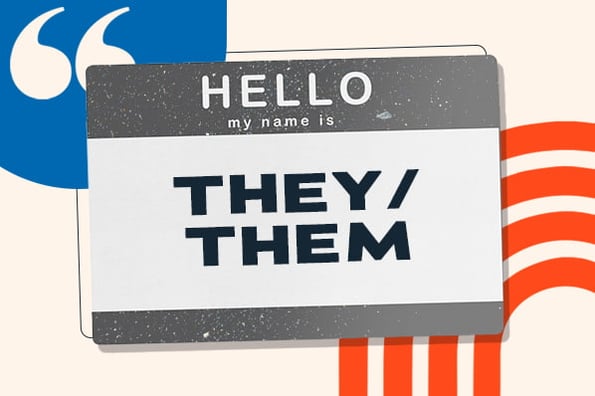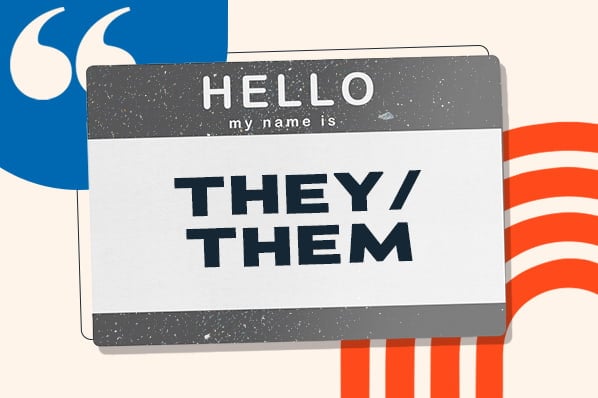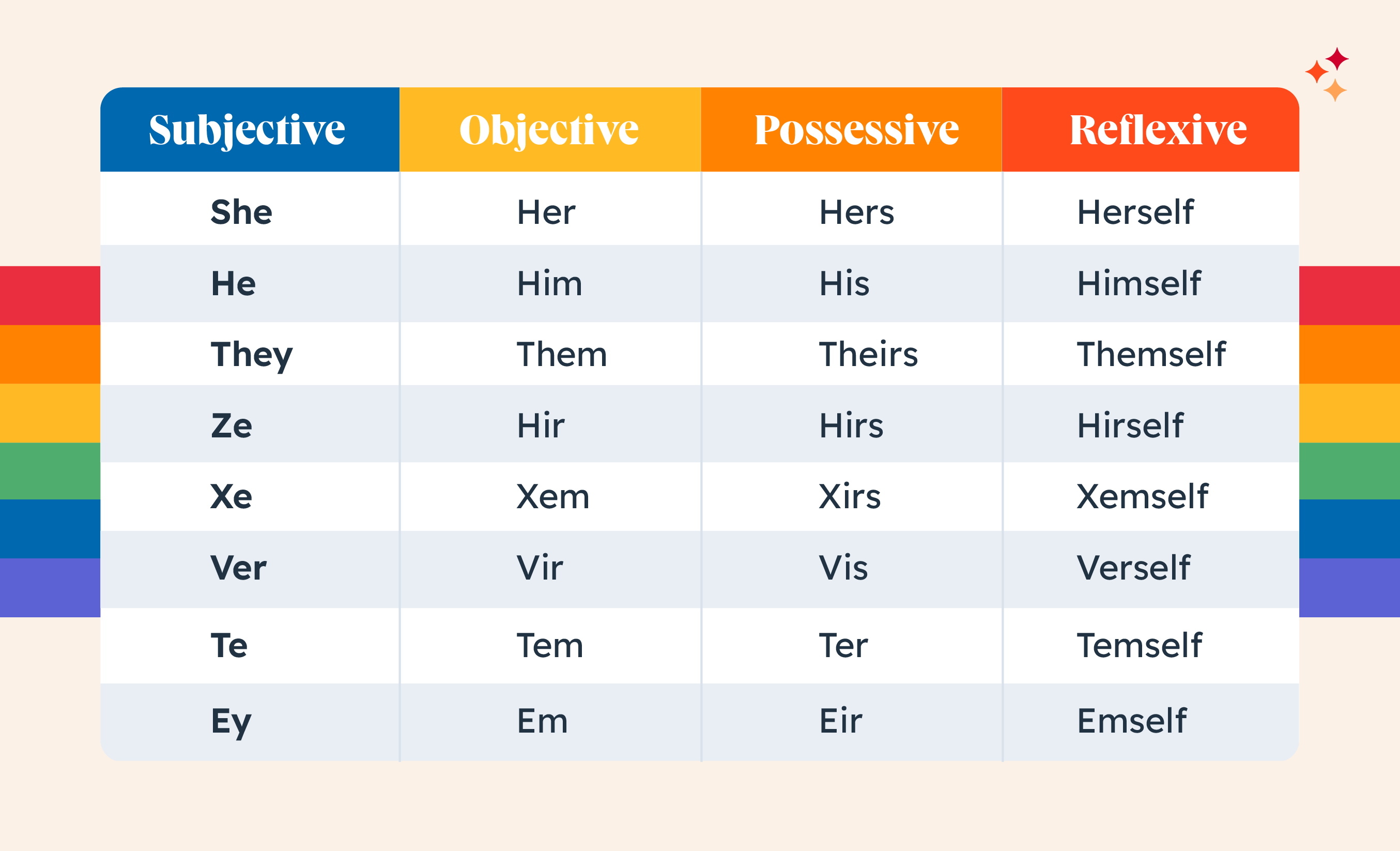
What They Are & How to Use Them
- July 6, 2023
- Knowledge Base
- 0 Comments

The world has made small but mighty strides towards inclusivity, and language plays a big part in that.

We’ve become rightfully aware of the importance of not labeling people, as everyone has the right to self-identify as they please and use validating pronouns.
Whether you want to brush up on your knowledge or are new to adopting them, this piece is your guide to gender neutral pronouns and how to use them.
Table of Contents
Gender Neutral Pronouns List
- She/her/hers
- He/him/his
- They/them/theirs
- Ze/hir/hirs
- Xe/xem/xyrs
- Ver/vir/vis
- Te/tem/ter
- E/em/eirs
The list above are common gender-neutral pronouns.
While she and he are considered gendered, some nonbinary people use them because they don’t feel attached to the gender typically associated with them.
Someone will typically share their own pronouns but, when it doubt, you can simply refer to someone by their name.

Gender Neutral Pronouns
Gender-neutral pronouns are don’t specify the gender of the subject of a sentence. ‘They,’ for instance, is a third-person pronoun that is gender neutral. Other gender-neutral pronouns include ‘them’, ‘this person’, ‘everyone’, ‘Ze’, or ‘Hir’. If you’re not sure which pronoun to use, you can also use that person’s name.
How to Use Gender Neutral Pronouns
In English, “He” is often used as an automatic fill-in for generic individuals.
“He” and “she” are also two extreme binaries that don’t leave room for other gender identities, which can be hurtful for transgender, nonbinary, and gender queer communities.
Ultimately, you probably don’t want to make incorrect or hurtful assumptions about someone’s gender — they could be agender, nonbinary, or uncomfortable identifying with “he” or “she.”
Gender-neutral language ensures your sentences are inclusive of everyone. But, when in doubt, refer to someone by their name rather than “him” or “her.”
“They” is one of the more common gender-neutral pronouns, and it’s easy to incorporate into your daily conversations. Here are some examples of how to use it:
- “I spoke to the marketing director and they said they’d get back to me.”
- “I think someone left their laptop behind.”
- “Who’s in charge of that campaign? I’ll email them.”
Let’s go over some examples of how you’d use other pronouns in conversation.
Ze/hir/hirs
- “Where did ze go?”
- “This pencil belongs to hir.”
- “Ze would rather do it hirself.”
Xe/xem/Xirs
- “I think xe is nice.”
- “Tell xem I say hello.”
- “That sandwich is xirs.”
Ver/vir/Vis
- “I think ver is nice.”
- “I borrowed vis pencil.”
- “I went to the store with vir.”
Te/tem/ter
- “Te went to the store.”
- “I borrowed it from tem.”
- “That’s ter dog.”
Ey/em/eir
- “Ey wrote me a note.”
- “That belongs to em.”
- “I asked to borrow eir pencil.”
Gender Neutral Pronoun Considerations
1. How to Learn Someone’s Pronouns
Upon first meeting someone, most people agree it’s best not to outright ask for pronouns because someone may feel like you’re assuming their gender identity. In some cases, it may put someone in a situation where they have to out themselves but don’t want to or aren’t ready to.
Instead, introduce yourself with your pronouns: “Hi, I’m Caroline, and my pronouns are she/her.” With this, you’re allowing the other person to share theirs, but not forcing them to.
If you do ask, there are ways to do so respectfully. For example, in a work meeting, you could say, “Before we start, I’d like to go around and share our names and pronouns if you’re comfortable sharing.” Then, people have the option to share or not to share.
During a one-on-one conversation, you could introduce yourself and share your pronouns first or say, “What are your pronouns?” or “Can you remind me of your pronouns?”
You could also include your pronouns in an email signature, social media profiles, or professional pages.
If you don’t ask for pronouns, it’s best to default to addressing someone by name. While many people consider they/them to be a gender-neutral option, some people may feel misgendered by it.
Featured Read: Why We Ask Each Other Our Pronouns
2. Aim to shy away from saying “preferred pronouns.”
Despite the popularity of the term “preferred pronouns,” it can be alienating as it can imply someone’s gender is a preference.
As mentioned, you don’t always want to ask someone about their pronouns and can instead share yours first. But, if you are asking, you can say any of the following instead of “preferred pronouns”:
- “What are your pronouns?”
- How would you like me to refer to you?
- How would you like to be addressed?
Featured Read: Gender Census 2023 Worldwide Report
3. What if someone uses multiple pronouns?
People might use multiple pronouns, like she/they or they/hirs. If someone shares that with you, they might also say they’re more comfortable with one over the other, or they’d like you to vary the pronouns you use in conversation.
That may seem challenging, but you’ve likely already done it before. For example, “He was late to work yesterday, so she had to lead the meeting.”
An example of how this would look in a conversation with someone using multiple pronouns is, “She went to the doctor because their cough hadn’t gone away for a few days.”
Featured Read: How To Affirm the People in Your Life Who Use Multiple Sets of Pronouns
4. How do you use gender neutral pronouns with titles and honorifics?
An honorific or title describes someone’s position in life or professional settings. Mrs., Mr., and Sir are examples of common honorifics, and there are gender neutral variations of them that someone might use:
- Mx. (the most common gender neutral honorific)
- Pr. (derived from person)
- Msr. (a mix of miss and sir)
- Misc. (miscellaneous)
Not everyone chooses a gender neutral honorific, so it’s best to follow their lead. If they share one, use it; if they don’t, you can avoid using one entirely.
Featured Read: Gender Neutral Titles and Why They Matter
5. Should I correct other people who make a mistake?
Some people won’t want to call attention to someone making a mistake, but others will appreciate you correcting people for them. If you have more of a relationship with the person who is misgendered, you can ask them directly what they’d like you to do, or you can say something like: “[Persons name] uses [pronoun],” and then continue the conversation.
If you don’t know someone’s preference and still want to support them, you can make sure you use the right pronouns if you talk about them. For example, if someone says, “He made an excellent point,” you could say, “I agree ze did make a good point.”
Featured Read: Misgendering Guide
6. You don’t have to ask everyone for their pronouns.
There are some cases where there is no need to ask for pronouns at all. For example, a brief encounter with a server at a restaurant doesn’t necessarily require knowing their pronouns, which is why defaulting to calling someone by their name is considered a best practice.
Featured Read: This Is Why Singular ‘They’ Is Such a Controversial Subject
7. Be open to continuous learning.
Everyone makes mistakes, and this holds true for pronouns. If you slip up, the best thing to do is acknowledge it immediately, say, “Sorry, I meant to say [pronoun],” and move on. If you realize after the fact, you can do the same thing but still keep it brief and move on.
On the other hand, making a mistake and then continuing to bring it up or say that it’s hard to remember can make someone feel awkward and like they’re a burden for having pronouns you’re not familiar with.
Be okay with making a mistake and committing to learning from it.
Featured Resource: Practice with Pronouns





